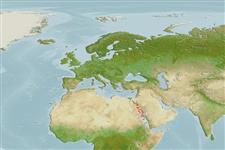Teleostei (teleosts) >
Anguilliformes (Eels and morays) >
Nettastomatidae (Duckbill eels)
Etymology: Facciolella: Latin, diminutive of falx, falcis = sickle (Ref. 45335).
Environment: milieu / climate zone / depth range / distribution range
Ecology
Marine; bathydemersal; depth range 700 - 2000 m (Ref. 9942). Deep-water
Distribution
Countries | FAO areas | Ecosystems | Occurrences | Point map | Introductions | Faunafri
Western Indian Ocean: Red Sea. Larvae were reported from the northwestern Indian Ocean.
Size / Weight / Age
Maturity: Lm ? range ? - ? cm
Floating or actively swimming larvae seem to live in the upper pelagic region. In the Red Sea, metamorphosing or post metamorphosed stages seem to descend vertically down to the deep-sea bottom.
Life cycle and mating behavior
Maturities | Reproduction | Spawnings | Egg(s) | Fecundities | Larvae
Klausewitz, W., 1994. Comparative studies on the vertical distribution of bathybenthic deep-sea fishes of the Red Sea. Proc. IPFC 4:462-468. (Ref. 9942)
IUCN Red List Status (Ref. 130435)
Threat to humans
Harmless
Human uses
Tools
Special reports
Download XML
Internet sources
Estimates based on models
Preferred temperature (Ref.
123201): 21.7 - 21.8, mean 21.7 °C (based on 10 cells).
Phylogenetic diversity index (Ref.
82804): PD
50 = 0.5156 [Uniqueness, from 0.5 = low to 2.0 = high].
Bayesian length-weight: a=0.00089 (0.00036 - 0.00223), b=2.98 (2.77 - 3.19), in cm total length, based on LWR estimates for this (Sub)family-body shape (Ref.
93245).
Trophic level (Ref.
69278): 3.4 ±0.4 se; based on size and trophs of closest relatives
Resilience (Ref.
120179): Medium, minimum population doubling time 1.4 - 4.4 years (Preliminary K or Fecundity.).
Fishing Vulnerability (Ref.
59153): Moderate to high vulnerability (47 of 100).
